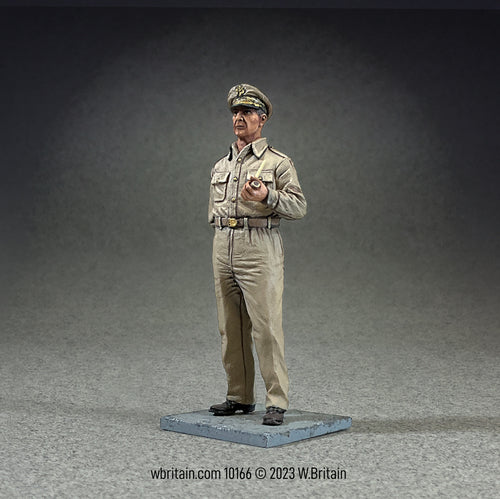25197 - U.S. Infantryman Running, No.2, 1943-45
$ 48.00
U.S. Infantryman Running, No.2, 1943-45
The close-quarter fighting that took place in ruined cities of World War II was possibly the most harrowing any soldier would experience. Though not a new development in the annals of war, street-to-street fighting in the rubble of a bombed-out European town was made even more perilous by two mitigating factors: modern weaponry and old buildings. Rapid-fire small arms could lay down a fusillade that would easily pin down any enemy movement through a physically restricted area, i.e. rubble. Town structures were often solidly constructed of thick, ancient stone and dense brick making each building a small fortress, impervious to reciprocal small arms attack. This meant you moved quick or you might not ever move again.
1/30 scale
Matte Finish
1 piece set
Related Items
10166 - U.S. General Douglas MacArthur, 1945
$ 48.00
NEW! IN STOCK! U.S. General Douglas MacArthur, 1945 Youngest son of a Union Civil War General and Medal of Honor recipient, Douglas MacArthur was himself nominated for the Medal of...
10167 - U.S.N. Admiral Chester W. Nimitz, 1944-45
$ 48.00
NEW! IN STOCK! U.S.N. Admiral Chester W. Nimitz, 1944-45 Chester William Nimitz entered the Naval Academy in 1905 and was an excellent student, graduating with distinction. Afterwards he joined the...
10168 - U.S.N. Commander Lyndon Baines Johnson, 1942-45
$ 48.00
NEW! IN STOCK! U.S.N. Commander Lyndon Baines Johnson, 1942-45 In 1938, Lyndon Baines Johnson was serving in the United States Congress. While a U.S. representative, he was appointed lieutenant commander...
10169 - U.S.N Lieutenant Jimmy Carter, 1948-51
$ 48.00
NEW! IN STOCK! U.S.N Lieutenant Jimmy Carter, 1948-51 James Earl Carter graduated from the U.S. Naval Academy in 1946 with distinction. When the nuclear-powered submarines came on-line, Carter was anxious...














